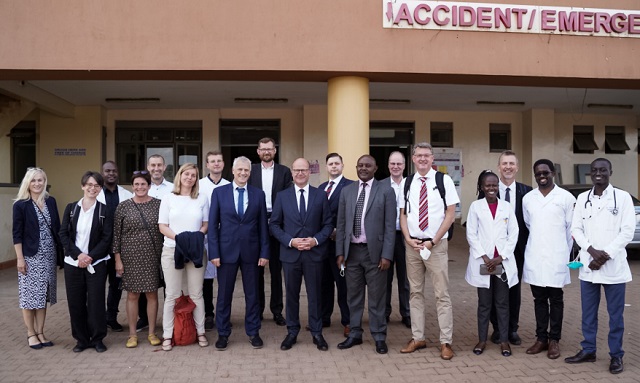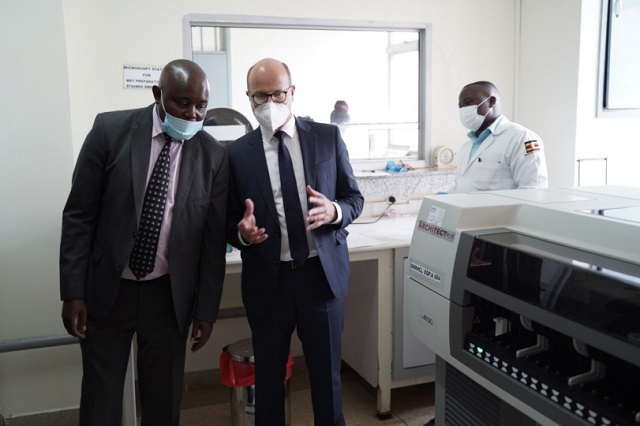
Lack of diagnostic facilities escalates the problem
Kampala, Uganda | PATRICIA AKANKWATSA | The problem of antimicrobial resistance in infectious agents has been rising, and there is global concern that in the absence of interventions to reverse this trend, the means to treat infectious diseases will be limited and out of reach for many; especially those living in low and middle-income countries.
One of the biggest causes of antimicrobial resistance is the lack of diagnostic facilities which makes targeted treatment impossible, and this has a significant impact on medical care for the majority of patients with infections; especially those with lower incomes.
While visiting Kiruddu Referral Hospital in Kampala on June 21 to check on the progress of setting up a modern microbiology laboratory, Oliver Schenk; Chief of the State Chancellery and State Minister of Saxony Germany, said infections and resistance to antibiotics are global health problems that tend to worsen due to the ongoing COVID-19 pandemic and its consequences; particularly in countries with less developed health systems.
“This is why the Leipzig University Medical Centre and, in Kampala, both the Infectious Diseases Institute at Makerere University and the Kiruddu National Referral Hospital, have formed a partnership to draw up a strategy for achieving direct and sustainable improvements in the care of patients with bacterial infections,” he said.
The project is part of the Government and the Federal States Programme (BLP), which is implemented by the Deutsche Gesellschaft für Internationale Zusammenarbeit (GIZ) GmbH on behalf of the German Federal Ministry for Economic Cooperation and Development (BMZ).
The strategy is designed to mitigate collateral damage due to COVID-19 and permanently strengthen the health system. The BLP project is setting up a modern microbiology laboratory at the Kiruddu National Referral Hospital to expand its diagnostic capacity.
According to Dr Michael Klingler Portfolio Manager, GIZ Uganda, microbiological diagnostic testing to identify pathogens and their respective resistance patterns are available to patients with infectious diseases in Kampala (Uganda) only as part of a scientific study or for a very small group of patients paying for themselves.
“The procedure for sending off samples for testing is complicated, and this delays the results,” he said.
Dr Charles Kabugho the executive director, of Kiruddu referral hospital, said he was honoured to have this partnership because the new microbiology laboratory will help in quick diagnosis.
“The laboratory came with a VITEK machine for diagnosing infections faster. Our microbiologists have attested to that. We now get results in 24 hours or less,”
The Ministry of Health Annual Health Sector Performance Report for 2020/2021 indicates that antimicrobial resistance is the second leading cause of hospital admission deaths, accounting for 2,944 mortalities.
At least 45,042 people died in hospitals in 2019/2020 while in 2020/2021, the number increased to 45,990.
Dr Andrew Kambugu, the director of the Infectious Disease Institute of Makerere University, says “antimicrobial resistance is having organisms not being able to be killed by drugs”.
“It is now estimated that antimicrobial resistance is now killing more people than non-communicable diseases,” he said.
Dr Grace Najjuka, the head of the National Microbiology Reference Laboratory says there are reports of high and unnecessary use of antimicrobials among patients.
“Examples of such practices include the use of antimalarials for fevers not associated with malaria, as well as the use of antibiotics for non-bloody diarrhoea and non-pneumonia upper respiratory infections that are commonly caused by viruses,” she says.
The Uganda National Academy of Science (UNAS) reported resistance to commonly used antimicrobials including ampicillin, ciprofloxacin and ceftriaxone used for bacterial infections, artemether-lumefantrine commonly used for malaria, as well as rifampicin and isoniazid used for tuberculosis.
Consequently, second- or third-line antimicrobials, which are more expensive and not readily available in health facilities, might be required to treat these common infections
Antimicrobials in Uganda are categorised under Class B by the National Drug Authority (NDA) the regulatory body for medicines in Uganda. This means these require a prescription before being dispensed. However, in practice, many of them are easily attainable from drug outlets such as pharmacies and drug shops without a prescription.
Prof Samuel Majalija, a microbiologist at Makerere University says self-medication and premature discontinuation of antimicrobials has also been observed in Uganda contributing to the development of antimicrobial resistance.
“These undesirable practices are drivers of the growing drug resistance of microorganisms across the country,” he says.

Interventions
By the 68th World Health Assembly resolution on the Global Action Plan of 2015, on Antimicrobial Resistance and the Prudent Use of Antimicrobials 2016, together with similar commitments by the Heads of State at the 2016 UN General Assembly and the Global Health Security Agenda, Uganda developed a National Action Plan (NAP) as a guiding framework for implementation of these global commitments at the country level.
This National Action Plan for Antimicrobial Resistance operates in conjunction with pre-existing programmes currently being undertaken by the Government of Uganda and various elements of policy and regulation.
The WHO GAP includes five strategic objectives that are aimed at slowing down the emergence and spread of antimicrobial resistance and prolonging the efficacy of existing antimicrobial agents.
Promote public awareness
According to NAP, there is a need to promote public awareness, training and education. Most Ugandans are not aware of the growing problem of antimicrobial resistance. This is not limited to the public but also pertains to human and animal health professionals.
Understanding antimicrobial use, resistance prevention and containment can be achieved only through raising awareness, effective communication, coordination, collaboration, education and training.
Social engagement is needed to ensure a critical change in behaviour in the way antimicrobials are used and to take action and promote the best practices necessary for slowing the problem of antimicrobial resistance.
Tuberculosis, HIV and malaria already have their national control programs, and these efforts will focus specifically on antibiotic resistance awareness.
To prevent the spread of resistant infections, it is important to implement infection prevention programs across human and animal communities and health care settings through individual and environmental sanitation and hygiene, as well as through biosecurity measures throughout the entire value chain from farm to plate.
Infection prevention and control (IPC) measures in healthcare facilities as well as immunisation and sanitation and hygiene in the community reduce the risk of transmission of infections and minimize the need for and use of antimicrobials.
Also ensuring access and appropriate use of safe and effective antimicrobials. Achieving optimal antimicrobial use will require strengthening technical and regulatory frameworks, ensuring the availability of appropriate medicines and changing behaviour among prescribers, dispensers and consumers.
Uganda must invest in research and innovations for tackling antimicrobial resistance including in areas such as the development of new diagnostics, preventives, therapeutic products and innovative ways of minimizing transmission of infectious agents and preventing infection.
****
 The Independent Uganda: You get the Truth we Pay the Price
The Independent Uganda: You get the Truth we Pay the Price




On Wedneday the 7th July the chair of the committee of Health presented findings from Eastern and central Uganda
In the report focus on maternal health, was used to reflect on performance;
I did not hear much about Central region apart from comments on constructions at Gombe hospital
Something was said about construction at Busolwe hospital too
The number of caeserian sections was noted, one reason behind these operations could be rise in blood pressure(BP) but we know antenatal clinics that run without BP machines
So we’re these available?
Catching them early would reduce the number that get complications to end up in theatre
We pray the theatres conform to the standard that minimise infection
Looking at antimicrobial resistance we hope that the report commented on the new structure being the type that supports practice of infection prevention and control
Having several hand wash basins in a ward, cleanable surfaces, proper air flow. An efficient incinerator
Needless to mention isolation rooms plus a TB Ward.
But one still feels that the approach was lacking in the area of sepsis ( forgive us if it was covered)
it is known to be one of the leading causes of death
So were the diagnostics adequate to ensure that the bugs causing sepsis will be treated with the right drug?
If you say this is not for that level of care was there ability to feed into the referral system?
The availability of the right medicines, when results become available
What about presence of thermometers to document fever?
Examining urine, or having full blood counts? Detection of syphilis is this routine ( mentioned still birth)?
In the area of routine practice,
this tool should have captured the supply of chlorine release compounds the availability of soap. The proportion of facilities with water present all the time
We look forward to hearing antimicrobial resistance being discussed at certain levels of decision making; if only to complement its contribution to poor treatment outcomes
The National Action Plan, has been here long enough for us to see some community activties;
Involvement of schools, the ordinary population and the Elite.
We have seen some institutions discussing the passing on of messages to control transmission of Covid-19
We also see religious leaders and cultural leaders disseminating some facts
It is our prayer that they also get involved in the activities of awareness of measures to control the development and control of antimicrobial resistance
With regard to IPC
The basic minimum emphasis is put on facility hygiene and hand hygiene complemented by waste management but even these have issues on and off while some are perennial
The issues of rendering equipment safe are another area of inconsistency
So when an infection appears, then a need to determine the cause and appropriate medicine to clear it become inevitable
There may be a need to isolate the infected from uninfected within the same health facility
These measures were oncr operational in this country. They may also be operational in some facilities
But the public facilities as they are, pose a nightmare!!
So does the low levels of staffing!
It becomes a duty of those with means to identify the gaps, and present them as they are for the common good
One fact may stimulate all “antimicrobial resistance and related dangers do not respect status”